Scottish Water treats 983ML* of wastewater per day.
Our biological treatment processes generate nitrous oxide (N2O) and methane (CH4). Both are greenhouse gases.
This is the equivalent of 43kt CO2e pa.
*1 ML (megalitre) = 1 million litres

2019/20 POSITION
PER DAY
WASTEWATER
TREATED
43kt CO2e
NITROUS OXIDE AND
METHANE PRODUCED
2019/20 POSITION
983ML
PER DAY
WASTEWATER
TREATED
43kt CO2e
PER ANNUM
NITROUS OXIDE AND METHANE PRODUCED
WASTEWATER
AERATION
WASTEWATER
SLUDGE TREATMENT
WASTEWATER
SLUDGE STORAGE
WASTEWATER
AERATION
WASTEWATER
SLUDGE TREATMENT
WASTEWATER
SLUDGE STORAGE
OUR APPROACH

REDUCE
EMISSION PRODUCTION
MAXIMISE ENERGY
RECOVERED FROM BIORESOURCE
These tables illustrate the key activities we are
exploring to reduce our process emissions.
We will keep these under review
with our expert advisory panel.

UP TO
2025
• Identify and implement more accurate measurement and accounting for process emissions.
UP TO
2030
UP TO
2040
• Demonstrate optimisation of WWTWs and Sludge Treatment Centres to decrease production of N2O.
• Implement optimisation of WWTWs and Sludge Treatment Centres to decrease production of N2O.
• Complete optimisation of WWTWs and Sludge Treatment Centres to decrease production of N2O.
• Identify, assess and demonstrate sludge storage and transport optimisation to decrease methane emissions.
• Implement sludge storage and transport optimisation to decrease methane emissions.
• Complete sludge storage and transport optimisation to decrease methane emissions.
• Technology scouting for innovative technology to reduce process emissions.

UP TO
2025
• Identify and implement more accurate measurement and accounting for process emissions.
• Demonstrate optimisation of WWTWs and Sludge Treatment Centres to decrease production of N2O.
• Identify, assess and demonstrate sludge storage and transport optimisation to decrease methane emissions.
• Technology scouting for innovative technology to reduce process emissions.
UP TO
2030
• Implement optimisation of WWTWs and Sludge Treatment Centres to decrease production of N2O.
• Implement sludge storage and transport optimisation to decrease methane emissions.
UP TO
2040
• Complete optimisation of WWTWs and Sludge Treatment Centres to decrease production of N2O.
• Complete sludge storage and transport optimisation to decrease methane emissions.
DEVELOP RECOVERY OF
AMMONIA FROM WASTEWATER
AVOIDING PROCESS EMISSIONS
DEVELOP METHANE
CAPTURE TECHNOLOGY,
AVOIDING PROCESS EMISSIONS
IDENTIFY CIRCULAR ECONOMY
OPPORTUNITIES FOR USE OF
RECOVERED AMMONIA
INNOVATION CHALLENGES
DEVELOP RECOVERY OF
AMMONIA FROM WASTEWATER
DEVELOP METHANE
CAPTURE TECHNOLOGY,
AVOIDING PROCESS EMISSIONS
IDENTIFY CIRCULAR ECONOMY
OPPERTUNITIES FOR USE OF
RECOVERED AMMONIA
INNOVATION CHALLENGES
DEVELOP RECOVERY OF
AMMONIA FROM WASTEWATER
DEVELOP METHANE
CAPTURE TECHNOLOGY,
AVOIDING PROCESS EMISSIONS
IDENTIFY CIRCULAR ECONOMY OPPORTUNITIES FOR USE OF RECOVERED AMMONIA
KEY ENABLERS TO SUPPORT
REDUCING PROCESS EMISSIONS
PEOPLE CAPABILITY
Expand our process
science skills
TECHNOLOGY
Developing improved process
monitoring equipment
MARKETS
Develop a quality product
for the circular economy
KEY ENABLERS TO
SUPPORT REDUCING PROCESS EMISSIONS
PEOPLE CAPABILITY
Expand our process
science skills
TECHNOLOGY
Developing improved process
monitoring equipment
MARKETS
Develop a quality product
for the circular economy
EXTERNAL FACTORS THAT SUPPORT
REDUCING PROCESS EMISSIONS
INCENTIVES
to stimulate technology
development for
energy recovery
INTERNATIONAL REVIEWS OF GREENHOUSE GAS
EMISSIONS FACTORS
for methane and
nitrous oxide
REGULATORY FRAMEWORK
EXTERNAL FACTORS THAT SUPPORT REDUCING PROCESS EMISSIONS
INCENTIVES
to stimulate technology
development for
energy recovery
INTERNATIONAL REVIEWS OF GREENHOUSE GAS
EMISSIONS FACTORS
for methane and
nitrous oxide
REGULATORY FRAMEWORK
INTRODUCTION

TRANSFORMATION



ELECTRICITY

PROCESS
EMISSIONS

GAS &
FUEL OIL

TRANSPORT
& TRAVEL

INVESTMENT

STORING
CARBON
Scottish Water has established a framework for the supply of sustainably sourced hydrotreated vegetable oil that can be used by both Scottish Water and its construction partners. It’s a drop in fuel replacement that reduces emissions by 90% compared to conventional diesel.
Over the last year it has been widely adopted by our construction partners, displacing diesel use in excavators, cranes and other heavy plant. It is also being used to fuel generators to provide power for remote construction sites.
On our water mains rehabilitation programme its adoption is expected to reduce emissions by nearly 30%.
Scottish Water has been a partner in a project, led by the local community and supported by the National Lottery’s Community Fund, to regenerate the site once occupied by Douglas Primary School as a multi-functional greenspace.
Our team worked with the community to incorporate sustainable drainage features in the new park, which store and slowly release the rainwater that falls on surrounding roads and rooftops during storms. This eases pressure on the combined sewer network in the local area, as well as helping to protect the local environment and reduce flood risk from the Dighty Burn. Importantly, the community has been able to realise its wider aims by creating an attractive outdoor space that also provides a home for wildlife; and can be enjoyed for play, relaxation, exercise, events and the growing of food.

Planning is now underway to introduce more sustainable water management measures in the area surrounding the park, with the aim of disconnecting over 40,000m2 of land area from the combined sewer network; and helping to enable the development of more social housing in Douglas. Engagement with the community, including schools and other key stakeholders, is being carried out to help shape the proposals.
Work with the community and Dundee City Council on sustainable drainage for Douglas has helped to inspire the Water Resilient Dundee partnership. This initiative is now pursuing opportunities for more sustainable management of stormwater across the city, reducing flood risk in communities, creating capacity for development and enhancing amenity.